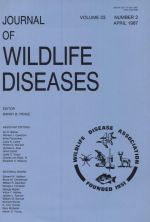A 10-week-old, black buck antelope calf, from the Mesker Park Zoo in Evansville, Indiana was found dead without observed signs of illness. Necropsy disclosed disseminated ecchymoses on the pericardium, diaphragm, intestines, and renal capsules and more extensive hemorrhage in the muscles of the hindquarters. There were numerous, 1 mm, pale foci on the capsular and cut surfaces of the liver and spleen which, on microscopic examination, were necrotic foci containing variable numbers of neutrophils and mononuclear leukocytes with numerous, short, Gram-positive, cocco-bacilli at the periphery. Listeria monocytogenes was isolated from the liver. Septicemia is the most common form of listeriosis in non-domestic ruminants. Listeriosis should be suspected when unexpected deaths are accompanied by multifocal necrotizing hepatitis and splenitis, myocarditis, and disseminated hemorrhage.
How to translate text using browser tools
1 April 1987
Listeriosis in an Immature Black Buck Antelope (Antilope cervicapra)
Dale M. Webb,
Alan H. Rebar

Journal of Wildlife Diseases
Vol. 23 • No. 2
April 1987
Vol. 23 • No. 2
April 1987
Antilope cervicapra
black buck calf
California
case report
Listeria monocytogenes
listeriosis




